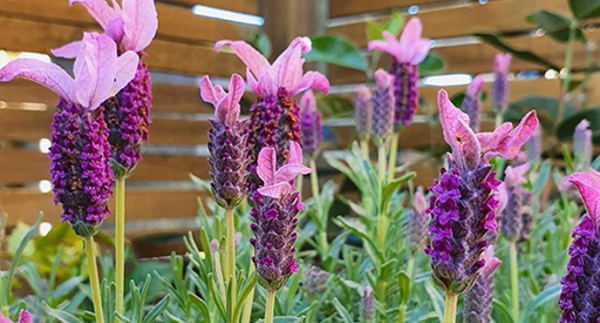
Photo by @kitchengardenz
5 Steps to Lavender Planting Success
- Choose a sunny spot with good drainage.
- Prepare your soil with organic matter like sheep pellets.
- Add a layer of rose & shrub mix to plant into. In New Zealand garden centres have the best range of lavender available in spring.
- Feed your lavender in spring to replenish nutrients.
- Prune your lavender once or twice a year to maintain shape.
Follow our full guide below to beautiful, fragrant lavender.
Not many plants can match lavender for both fragrance, foliage and flowers. The fragrance is renowned for its relaxing properties, and the flowers are popular to pick for the vase. As a dried flower it’s a common element in potpourri blends. They’re not long-living plants though, 10 years is a good innings for a lavender plant.
Prepare
Lavender is relatively easy to grow – with a sunny spot and good drainage it happily thrives for several years. When planting lavender choose a site in full sun for the best results. Lavender is very tolerant of cold winters provided the soil remains free-draining, waterlogged winter soils are not suitable for lavender. Garden centres have the best range available in spring.
The main types grown in New Zealand are English lavender, Lavandula stoechas and French lavender.
Like building a house a good foundation is the key to success in your garden. The better the soil, the better your plants will grow. If you are starting with an existing garden bed dig in organic matter like Tui Sheep Pellets to your soil. Then you can add a layer of Tui Rose & Shrub Mix.
Less is more with lavender, choose one variety and mass plant it rather than planting lots of different varieties. If you're looking to create a hedge, space plants 30-50cm apart.
PLANT
The best times to plant are early in the morning or late in the day, so the plants aren’t exposed to the hot sun straight away. Always water plants well before and after planting.
Directions for planting in garden beds
- Water plants thoroughly before planting and allow to drain.
- Dig a hole, approximately twice the depth and width of the root ball of your plant.
- Gently loosen the root ball of your plant and position the plant in the centre of the hole.
- Fill in with Tui Rose & Shrub Mix.
- Press soil gently around the base of the plant.
- Water your plant well and continue to water regularly.
Directions for potting plants
- Water plants thoroughly before potting and allow to drain.
- Half fill your container with Tui Rose & Shrub Mix.
- Gently take the plant from the current container, loosen the root ball and remove any loose or dead plant material and roots.
- Position the plant in the centre of the new container and fill with Tui Rose & Shrub Mix up to 3cm from the top.
- Gently firm mix around the base of the plant. The mix should be at the same level on the plant as it was in the previous container.
- Water your plant well and continue to water regularly.
Nourish
Feed your lavender and it will reward you. Plants use nutrients from the soil as they grow, so replenishing the nutrients ensures your plants grow to their full potential. Feed lavender with Tui NovaTec® Premium Fertiliser in spring.
A well watered, well nourished garden will have a better chance of keeping insect pests and diseases at bay. While your lavender are growing regularly apply a dose of Tui Organic Seaweed Plant Tonic to give them a welcome boost.
Pruning
Pruning is key to maintaining good-looking lavender. The best time to trim lavender to prevent it from becoming “woody” is after flowering. Remove the spent flowers and trim back the foliage by about one third. If they flush and flower again in late summer, after the second flush has finished flowering, trim the plants back and remove spent flower heads. The exception is Stoechas (French, Italian) type lavenders which are frost tender. If there is a second flush of flowering, leave the flowers on the bush until after winter and frosts have past, trim back in early spring.
Less is more with lavender; choose one variety and mass-plant as opposed to planting a number of different varieties.